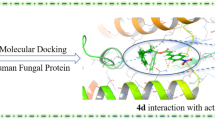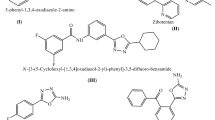Abstract
From the earlier quantitative structure–activity relationship (QSAR) and molecular modeling studies, a series of quinoline derivatives 5a–h mimicking terbinafine and containing different bulky aromatic rings in the side chain were designed using LeapFrog, a de novo drug design program. The designed compounds were synthesized and screened for antifungal activity in vitro against C. albicans. Of the ten compounds designed and synthesized, compounds 5c, d, f, h, and i exhibited minimum inhibitory concentration (MIC) in the range 4–25 μg/ml and were further evaluated for oral toxicity in animal model. The pharmacokinetic properties for these compounds were estimated in silico and compared with terbinafine. Compound 5h, N-methyl-N-[(2-naphthyl)methyl]-8-quinolinemethanamine, was found to be least toxic, possessing pharmacokinetic parameters close to those of terbinafine.

Similar content being viewed by others
References
Akova MHE, Akalin OU, Gur D (1991) Emergence of Candida Krusei infections after thaerapy of oropharyngeal candidiasis with fluconazole. Eur J Clin Microbiol Infect Dis 10:598–599. doi:10.1007/BF01967286
Beck-Sague CM, Jarvis WR (1993) Secular trends in the epidemiology of nosocomial fungal infections in the United States. J Infect Dis 167:1247–1251
Boobisa A, Gundert-Remyb U, Kremersc P, Macherasd P, Pelkonene O (2002) In silico prediction of ADME and pharmacokinetics. Report of an expert meeting organized by COST B15. Eur J Pharm Sci 17:183–193
Clark DE, Pickett SD (2000) Computational methods for the prediction of “drug-likeness”. Drug Discov Today 5:49–58
Clark M, Cramer RD, Van Opdenbosch N (1989) Validation of the general purpose Tripos 5.2. Force field. J Comput Chem 10:982–1012
Denning DW (1991) Epidemiology and pathogenesis of systemic fungal infections in the immunocompromised host. J Antimicrob Chemother 28(Suppl. B):1–6
Diamond RD (1991) The growing problem of mycosis in patients infected with the human immunodeficiency virus. Rev Infect Dis 13:480–486
Gokhale VM, Kulkarni VM (1999) Comparative molecular field analysis of fungal squalene epoxidase inhibitors. J Med Chem 42:5348–5358
Hawkey PM, Lewis DA (1994) Medical bacteriology—a practical approach. Oxford University Press, UK, pp 181–194
Hitchcock CA (1991) Cytochrome P-450-dependent 14a-sterol demethylase of Candida albicans and its interaction with azole antifungals. Biochem Soc Trans 19:782–787
Johnson DE, Wolfgang GH (2000) Predicting human safety: screening and computational approaches. Drug Discov Today 5(10):445–454
Lipinski CA, Lombardo F, Dominy BW, Feeney PJ (1997) Experimental and computational approaches to estimate solubility and permeability in drug discovery and development settings. Adv Drug Deliv Rev 23:3–25
Nes WR, Sekula BC, Nes WD, Alder JH (1979) The functional importance of structural features of ergosterol in yeast. J Biol Chem 253:6218–6225
Nussbaumer P, Petranyi G, Stutz A (1991) Synthesis and structure-activity relationships of benzo[b]thienylallylamine antimycotics. J Med Chem 34:65–73
Nussbaumer P, Dorfstatter G, Grassberger MA, Leither I, Meingasser JG, Thirring K, Stutz A (1993a) Synthesis and structure-activity relationships of phenyl substituted benzylamine antimycotics: a novel benzylbenzylamine antifungal agent for systemic treatment. J Med Chem 36:2115–2120
Nussbaumer P, Dorfstatter G, Leitner I, Mraz K, Vylpel H, Stutz A (1993b) Synthesis and structure-activity relationships of naphthalene substituted derivatives of the allylamine antimycotic terbinafine. J Med Chem 36:2810–2816
Nussbaumer P, Leither I, Stutz A (1994) Synthesis and structure-activity relationships of the novel homopargylamine antimycotics. J Med Chem 37:610–615
Nussbaumer P, Leither I, Mraz K, Stutz A (1995) Synthesis and structure-activity relationships of the allylamine antimycotic terbinafine lacking the central amino function. J Med Chem 38:1831–1836
Odds FC (1993) Resistance of yeasts to azole derivative antifungals. J Antimicrob Chemother 31:463–471
Paltauf F, Daum G, Zuder G, Högenauer G, Schulz G, Seidl G (1982) Squalene and ergosterol biosynthesis in fungi treated with naftifine, a new antimycotic agent. Biochimica et Biophysica Acta (BBA) – Lipids and Lipid Metabolism 712:268–273
Petranyi G, Ryder NS, Stutz A (1984) Allylamine derivatives: new class of synthetic antifungal agents inhibiting fungal squalene epoxidase. Science 224:1239–1241
Richardson MD (1991) Opportunistic and pathogenic fungi. Antimicrob Agents Chemother 28(Suppl.A):1–11
Roder BL, Sonnenschein C, Hartzen SH (1991) Failure of azole therapy in Candida Krusei fungemia. Eur J Clin Microbiol Infect Dis 10:173
Ryder NS (1985) Specific inhibition of fungal sterol biosynthesis by SF 86–327, a new allylamine antimycotic agent. Antimicrob Agents Chemother 27:252–256
Stewart JJP (1990) New approach (tool) to chemical research; computer aided molecular design. J Comput Aided Mol Des 4:1–45
Subramanian K (2005) truPK—human pharmacokinetic models for quantitative ADME prediction. Expert Opin Drug Metab Toxicol 1:555–564
Acknowledgements
One of the authors (M.N. Deodhar) is thankful to All India Council for Technical Education, New Delhi for the award of Doctoral Fellowship under its Quality Improvement Programme. The authors are thankful to Dr. S.S. Kadam.
Author information
Authors and Affiliations
Corresponding author
Rights and permissions
About this article
Cite this article
Kharkar, P.S., Deodhar, M.N. & Kulkarni, V.M. Design, synthesis, antifungal activity, and ADME prediction of functional analogues of terbinafine. Med Chem Res 18, 421–432 (2009). https://doi.org/10.1007/s00044-008-9138-8
Received:
Accepted:
Published:
Issue Date:
DOI: https://doi.org/10.1007/s00044-008-9138-8




